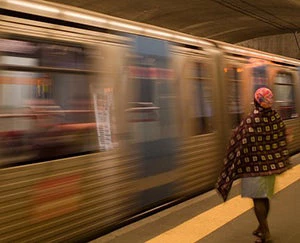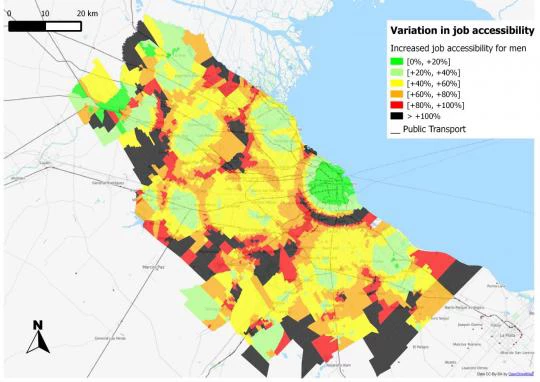Follow the authors on Twitter:
@shomik_raj
and
@tatipq
 The World Bank recently financed an urban mobility survey in greater Buenos Aires to explore the gender dimension of commuting – an issue we (and our co-author Catalina Ochoa) have been interested in for quite some time.
The World Bank recently financed an urban mobility survey in greater Buenos Aires to explore the gender dimension of commuting – an issue we (and our co-author Catalina Ochoa) have been interested in for quite some time.
There is plenty of evidence that even in relatively sophisticated middle class settings such as in Buenos Aires, ‘traditional’ gender roles survive – women, particularly women with children, have more complex travel patterns than their male counterparts. They travel more, they have more travel needs at off-peak hours than men, and these non-work travel needs are often associated with fixed destinations (e.g. child care). The mobility survey confirmed that the trends observed in Buenos Aires were similar to findings across the world including Europe, US [i], as well as nations in the global south like Peru and Vietnam [ii].
Comparing men and women’s mobility patterns: Women spend as much time commuting as men, but cover shorter distances
We were interested in finding out how these constraints may affect women’s job opportunities. Somewhat to our surprise, our initial look at the data did not highlight any significant differences; average commute times for men and women in the labor force were about the same (47.47min and 47.10 min respectively) across all income and socio-economic groups. This similarity of men and women’s average commute time is consistent with a body of evidence [iii] that suggests that average commute times across societies, trip types, travel time dispersions and income levels remains quite stable.
However, once we started taking a closer look at our data, we found out that those similarities in men and women’s commuting patterns were largely deceptive: as geo-coded trip patterns reveal, men and women’s average commuting times may be roughly the same, but men actually travel at significantly faster speeds and, as a consequence, cover larger distances. In general, trips made by women, particularly women with children were made at significantly lower travel speeds. (see table below: women with children, for instance, travel an average distance of 7.92km at an average speed of 9.98km/hr, as opposed to an average distance of 9.96km for men with children, which translates into a speed of 12.27km/hr).
How can we explain those differences? Our hypothesis is that women’s travel choices are limited in part by household maintenance activities, which force them to rely on comparatively slower modes: the survey finds that women walk more than men and take buses, while men are using cars and trains more.
If women are indeed constrained to smaller commutes, it also means they have access to fewer employment opportunities – with inevitable consequences on their wage rates and related labor market outcomes. The map below highlights the stark contrast in job accessibility between men and women in the Buenos Aires Metropolitan Area: in parts of the city, men with children have access to over 80% more jobs than their female counterparts.

 The World Bank recently financed an urban mobility survey in greater Buenos Aires to explore the gender dimension of commuting – an issue we (and our co-author Catalina Ochoa) have been interested in for quite some time.
The World Bank recently financed an urban mobility survey in greater Buenos Aires to explore the gender dimension of commuting – an issue we (and our co-author Catalina Ochoa) have been interested in for quite some time.
There is plenty of evidence that even in relatively sophisticated middle class settings such as in Buenos Aires, ‘traditional’ gender roles survive – women, particularly women with children, have more complex travel patterns than their male counterparts. They travel more, they have more travel needs at off-peak hours than men, and these non-work travel needs are often associated with fixed destinations (e.g. child care). The mobility survey confirmed that the trends observed in Buenos Aires were similar to findings across the world including Europe, US [i], as well as nations in the global south like Peru and Vietnam [ii].
Comparing men and women’s mobility patterns: Women spend as much time commuting as men, but cover shorter distances
We were interested in finding out how these constraints may affect women’s job opportunities. Somewhat to our surprise, our initial look at the data did not highlight any significant differences; average commute times for men and women in the labor force were about the same (47.47min and 47.10 min respectively) across all income and socio-economic groups. This similarity of men and women’s average commute time is consistent with a body of evidence [iii] that suggests that average commute times across societies, trip types, travel time dispersions and income levels remains quite stable.
However, once we started taking a closer look at our data, we found out that those similarities in men and women’s commuting patterns were largely deceptive: as geo-coded trip patterns reveal, men and women’s average commuting times may be roughly the same, but men actually travel at significantly faster speeds and, as a consequence, cover larger distances. In general, trips made by women, particularly women with children were made at significantly lower travel speeds. (see table below: women with children, for instance, travel an average distance of 7.92km at an average speed of 9.98km/hr, as opposed to an average distance of 9.96km for men with children, which translates into a speed of 12.27km/hr).
| Average Time (min) |
Average Distance (km) |
Average Speed (km/hr) |
|
| Women without Children |
45.3 |
7.50 |
9.92 |
| Men without Children |
43.3 |
8.67 |
12.01 |
| Women with Children |
47.7 |
7.92 |
9.98 |
| Men with Children |
48.7 |
9.96 |
12.27 |
How can we explain those differences? Our hypothesis is that women’s travel choices are limited in part by household maintenance activities, which force them to rely on comparatively slower modes: the survey finds that women walk more than men and take buses, while men are using cars and trains more.
If women are indeed constrained to smaller commutes, it also means they have access to fewer employment opportunities – with inevitable consequences on their wage rates and related labor market outcomes. The map below highlights the stark contrast in job accessibility between men and women in the Buenos Aires Metropolitan Area: in parts of the city, men with children have access to over 80% more jobs than their female counterparts.

Percentage of increased accessibility to employment opportunities for men with children relatively to women with children at the radio census level in the AMBA region. Data sources: Logit, background map layer: OpenStreetMap, processed by CIRED
Taking action: further analysis and policy recommendations
Moving forward, these findings suggest some avenues for future inquiry as well as considerations for policy makers. Using a combination of qualitative, quantitative and time-series methods could help us gain a better understanding of the underlying causes of women’s mobility disadvantage, and would allow us to analyze the linkage between commuting constraints and labor market choices more thoroughly.
For policy makers, we need to explore how to adapt transport systems so they can suit women’s needs better. Potential interventions may include:
See attached paper for more detail – comments and questions welcomed.
Moving forward, these findings suggest some avenues for future inquiry as well as considerations for policy makers. Using a combination of qualitative, quantitative and time-series methods could help us gain a better understanding of the underlying causes of women’s mobility disadvantage, and would allow us to analyze the linkage between commuting constraints and labor market choices more thoroughly.
For policy makers, we need to explore how to adapt transport systems so they can suit women’s needs better. Potential interventions may include:
- Improving mobility during the time of day and along the routes that are used by women. Supporting infrastructure and a culture for bicycling could be part of the solution.
- Evaluating public transport routes and services in a critical and systematic way to make sure they are supportive of such trips
- Innovative tariff structures such as free transfers (particularly for trips with short breaks to run errands) and monthly/weekly/daily passes
- Infrastructure changes like co-locating retail, childcare, healthcare and municipal services (bill payments, etc.) around transport hubs to address the travel needs of women better.
- We also need to consider the role that cars may be playing in lowering gender-related constraints.
See attached paper for more detail – comments and questions welcomed.
[i] Stanford University, Gendered Innovations
[ii] Levy, C. (2013), Travel choice reframed: ''deep distribution'' and gender in urban transport, Environment and Urbanization April 1, 2013 25: 47-63
[iii] Kwan, MP. (2000a). Gender differences in space-time constraint. Area 32(2):145-156.
Kwan, MP. (2000b) Evaluating Gender Differences in Individual Accessibility: A Study Using Trip Data Collected By the Global Positioning System
WBCSD (2001) Mobility 2001: World mobility at the end of the 20th century
Photo credit: Juha Riissanen
Kwan, MP. (2000b) Evaluating Gender Differences in Individual Accessibility: A Study Using Trip Data Collected By the Global Positioning System
WBCSD (2001) Mobility 2001: World mobility at the end of the 20th century
Photo credit: Juha Riissanen



Join the Conversation